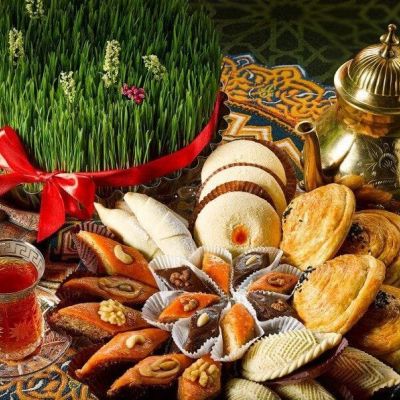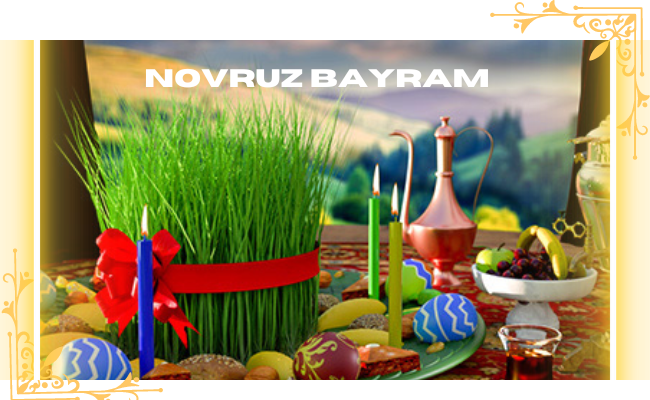Novruz (Azerbaijani: Novruz Bayram) is a traditional celebration celebrating the spring equinox and the arrival of spring. When Azerbaijan was part of the Soviet Union, Novruz celebrations were typically unofficial and, in some cases, outlawed. In Azerbaijan, Novruz is now considered an official public holiday. Workers are given five days off for Novruz under Article 105 of Azerbaijan’s Labour Code, which was established in 2006. After neighboring Iran, Azerbaijan holds the longest observance and number of public days associated with Novruz, with a total of five days (including the weekend).

Novruz Preperation and celebration
Typically, preparation for Novruz begins a month before the holiday. Every Tuesday, they celebrate one of the four elements: water, fire, wind, and earth. People clean houses, plant plants, make new outfits, paint eggs, and prepare national pastries such as shekerbura, pakhlava, and shorgoghal, in addition to a wide range of national food. Wheat is cooked with raisins (kishmish) and nuts (govurga). Every Tuesday during the four weeks leading up to the occasion, youngsters jump over little bonfires, and candles are lit in honor of pre-Islamic Zoroastrianism. On the festival eve, relatives’ graves are visited and tended.
During Novruz, musical gatherings include a variety of traditional games and shows, including “Kos-kosa” (which represents the arrival of spring), “Khidir Ilyas” (which represents fertility and flowering), and fortune-telling. Folk singers perform songs as wrestlers demonstrate their strength.
Novruz is a family holiday. The entire family gathers around the holiday table, which is laden with numerous meals to ensure a prosperous New Year. The event lasts several days and culminates in celebratory public dancing, national sports competitions, and other entertainment provided by folk bands.
Khoncha is the term used to describe celebratory table decorations. A big silver or copper tray with Samani (green shoots from wheat seeds) is placed in the center, along with candles and colorful eggs. Customs stipulate that the table should be set with at least seven dishes.
Charshanbas
The last four Tuesdays of winter (usually starting from the last Tuesday of February) before Novruz are celebrated by Azerbaijanis and called as “Charshanba”. According to Azerbaijani traditions, “Charshanbas” indicates the end of winter and the start of spring. According to folk belief, the first Charshanba represents water and celebrates its purifying nature.
The second Charshanba relates to the element of fire. It is believed that the action of jumping over bonfires and lighting candles renews a person and purges them of illness, allowing them to start the spring with positivity.
The third Charshanba in Azerbaijani tradition represents wind, which brings the beginning of spring to the air. In some western regions of Azerbaijan, the people call this day Black Wednesday. Azerbaijanis are supposed to visit and restore the graves of their relatives
The fourth and last Charshanba represents earth, known as “Torpag Chershenbesi” or “Ilakhir Charshanba”. It is believed that on this day nature revives again. Azerbaijanis consider this Charshanba as the most important among the four and hold special traditions related to this day. For example, there should be seven varieties of food on the table and all of their names must start with the letter ‘s’ in Azerbaijani, such as sumakh (a kind of spice), sud (milk), sirke (vinegar), samani (prepared from wheat), and so on. Folk tales say that on the evening of the fourth Charshanba, young girls can see their future husbands by approaching a mirror with a candle in their hands. Children knock at the doors of neighboring houses and leave their hats or bags, hoping for candies and desserts that are specially prepared for the holiday such as shakarbura and pakhlava
Ceremonies During the Novruz
During the Novruz celebration, various Novruz-related songs are sung, and varied activities such as tightrope walking and wrestling are held in public areas. Another tradition involves growing samani in a dish, which represents the fertility of spring. One particularly memorable aspect of the event is the customary humorous rendition of the story of Kosa and Kecel, two constant characters in the holiday storyline. These characters and their battles symbolize the war between Winter and Spring. At the end of the ceremony, Kecel wins the duel, symbolizing Spring’s victory over Winter. The Novruz holiday lasts around a week in Azerbaijan.
